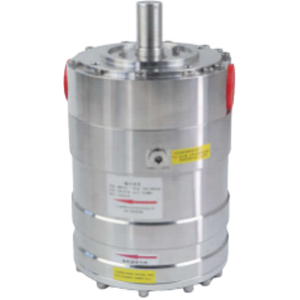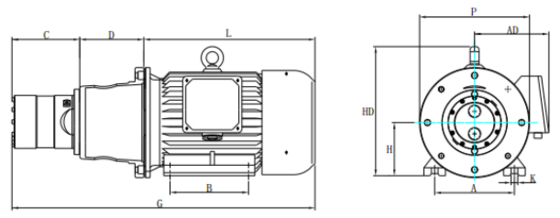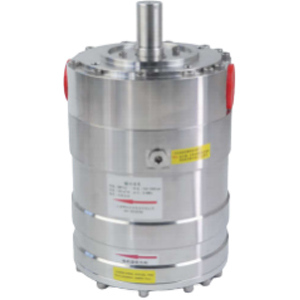In large-scale industrial water treatment systems, especially high-demand industrial reverse osmosis (RO) setups, the reliability of Water Treatment Consumables directly determines operational stability, efficiency, and long-term cost-effectiveness. The DHP 16 Axial Piston Pump, jointly developed by Wuxi Fenigal Science and Technology Co., Ltd. and its OEM partner Shenzhen CW Environment Technology, is a high-performance high-pressure pump tailored for large-scale industrial RO scenarios. As a core component in Water Treatment Consumables, it solves the critical challenge of conveying high-pressure, low-viscosity corrosive fluids, making it indispensable for large seawater desalination plants, industrial wastewater zero-liquid discharge projects, and food/pharmaceutical membrane concentration processes.
The DHP 16 Axial Piston Pump is a flagship model in Fenigal’s DHP series, built on over 30 years of expertise in high-pressure plunger pump R&D. Since 1990, Fenigal has focused on breaking foreign equipment monopolies in the field, and the DHP 16 further strengthens its large-flow high-pressure pump product matrix—solidifying its position as a trusted provider of premium Water Treatment Consumables.
At its core, the pump operates on the axial piston principle: plungers move reciprocally parallel to the drive shaft within plunger bores, creating volume changes that enable efficient, high-pressure fluid transfer. A defining innovation that sets it apart from ordinary Water Treatment Consumables is its fluid self-lubrication technology. Unlike traditional plunger pumps that rely on a lubricating oil tank (a common source of oil leakage), the DHP 16 uses the conveyed liquid as the lubricant, eliminating oil contamination risks entirely. This makes it ideal for scenarios with strict medium purity requirements, such as dairy product concentration or traditional Chinese medicine extract purification—where even minor oil pollution would render products unqualified.
Additionally, the pump integrates a standard flush check valve. When the pump stops, this valve locks in one-way fluid flow from inlet to outlet, preventing medium backflow that could damage the pump’s seals and reverse osmosis membranes (another high-value Water Treatment Consumable). In terms of durability and performance, the DHP 16 inherits three core advantages of the DHP series:
- Superior Corrosion Resistance: Key components are crafted from 2205 duplex stainless steel (SAF 2205 / EN 1.4462 / UNS 31803), offering exceptional resistance to high-salt and highly corrosive fluids (e.g., seawater, coal-fired power plant desulfurization wastewater). This ensures long-term stable operation in harsh water treatment environments, a must for durable Water Treatment Consumables.
- Low Noise & Low Vibration: Its pulsation amplitude is far lower than that of centrifugal pumps, and the optimized multi-plunger design controls noise at ≤85 dB(A) (per EN ISO 3744-2010). This meets the strict environmental requirements of food and pharmaceutical workshops, where excessive noise can disrupt production.
- Space-Saving Compactness: Despite its large-flow capacity, the pump can be directly installed on motors or internal combustion engines, requiring no extra large space. This is critical for space-constrained scenarios like coastal factories or island desalination stations, where efficient use of area is essential.
For users selecting Water Treatment Consumables for large-scale industrial RO, accurate technical parameters are critical to ensure compatibility and avoid system bottlenecks. The DHP 16’s parameters are optimized for high-flow, high-pressure demands, as detailed in the table below:
As a fixed-displacement axial piston pump, the DHP 16’s flow rate has a strict proportional relationship with the input shaft rotation speed— a key feature that enhances its adaptability as a Water Treatment Consumable for large systems. Users can adjust the motor speed to match dynamic flow demands using the formula:
Selected Motor Rotation Speed (r/min) = (Required Flow Rate (m³/h) × Rated Rotation Speed (1500 r/min)) / Rated Flow Rate (15.8 m³/h)
For example, at 700 rpm, the pump delivers approximately 7.4 m³/h of flow, while at the rated 1500 rpm, it reaches 15.8 m³/h. This flexibility allows it to adapt to varying demands, such as peak municipal water supply periods or fluctuating wastewater volumes in factories, while maintaining consistency with other Water Treatment Consumables.
Energy costs are a major consideration for large-scale water treatment systems. The DHP 16’s power requirements are optimized to balance high performance and efficiency, helping users select the right motor and avoid overload—protecting both the pump and other Water Treatment Consumables. The table below outlines its power values at typical pressures:
Proper installation and operation are vital to maximizing the DHP 16’s lifespan and preserving the integrity of other Water Treatment Consumables (e.g., RO membranes, high-pressure filters). Below are the core guidelines:
Large-scale RO media (e.g., seawater, chemical wastewater) often contains tiny particles that can damage the pump’s internal precision components (such as the narrow clearance between plungers and plunger sleeves). To prevent this, a 10 μm absolute accuracy depth filter (a critical supporting Water Treatment Consumable) must be installed at the pump’s inlet. This filter must achieve 99.98% filtration efficiency for particles larger than 10 μm (β10>5000). Bag filters (with only 90% efficiency) are prohibited, as they cannot block fine particles—leading to rapid pump wear and increased replacement costs for Water Treatment Consumables. Spiral-wound filter elements are strongly recommended.
- Low-Pressure Protection: Install a low-pressure control switch (set to 1 Bar) at the inlet. If pressure drops below 1 Bar, the pump shuts down automatically, preventing cavitation that can scratch plungers and damage seals (expensive Water Treatment Consumables to replace).
- High-Pressure Protection: Install a high-pressure control switch (set to 70 Bar) between the pump’s outlet and the RO membrane. This stops the pump in case of overpressure, protecting the membrane—a core Water Treatment Consumable that is costly to repair or replace in large systems.
- Safety Valve: A safety valve (per Chapter 10 of the product manual) is mandatory to absorb instantaneous pressure spikes after startup, avoiding damage to the system and Water Treatment Consumables.
Before starting the pump:
- Thoroughly flush pipelines and the system to remove welding slag, debris, or rust that could clog the pump or scratch RO membranes.
- Use the pump body’s exhaust valve to discharge air from the pump and system, preventing cavitation.
- Confirm the pump’s rotation direction matches the arrow on the pump body.
- Critical Warning: Never start the pump with the outlet valve closed. This can cause frequent safety valve activation or pipeline bursts, leading to costly downtime and repairs for the pump and surrounding Water Treatment Consumables.
The DHP 16’s dimensions are designed for easy integration with large-scale water treatment setups. Its inlet and outlet feature M52×1.5 threads (21 mm depth)—deeper than smaller models to ensure secure sealing for high-pressure fluids—requiring matching high-pressure pipe fittings (another essential Water Treatment Consumable). When paired with a frequency conversion motor, the complete equipment’s dimensions vary by motor power, as shown below (Unit: mm):
Proper maintenance ensures the DHP 16— a high-value Water Treatment Consumable—delivers long-term reliability, while Fenigal’s comprehensive warranty services minimize downtime for large-scale systems.
- Daily Maintenance: Monitor noise and vibration in real time. If abnormalities occur (e.g., sudden noise increases), shut down the pump immediately to inspect for plunger wear, seal aging, or insufficient inlet pressure. In high-salt environments (e.g., seawater desalination), flush the pump cavity with fresh water after each shutdown to remove concentrated brine—start the pump briefly during flushing to expel residual brine and prevent salt crystallization from damaging components.
- Shutdown Maintenance: For short-term shutdowns (≤3 days), keep the pump filled with medium (no flushing needed). For medium-term shutdowns (3~15 days), flush thoroughly with fresh water. For long-term shutdowns (>15 days), use bactericide-infused fresh water to flush, then seal inlet/outlet to block impurities.
- Regular Inspection: After 8000 hours of operation, conduct full disassembly. Replace worn parts (e.g., seal plates, plunger sleeves)—essential Water Treatment Consumables—and check check valve tightness to avoid internal leakage. Inspect thread wear on inlets/outlets and replace gaskets promptly.
Fenigal provides end-to-end support for this Water Treatment Consumable, ensuring large-scale systems run smoothly:
- Large-Scale Scenario Adaptability: Tailored for large seawater desalination, industrial wastewater zero-liquid discharge, and food/pharmaceutical concentration—meeting high-flow, high-pressure demands as a core Water Treatment Consumable.
- Superior Reliability: Self-lubrication and 2205 stainless steel eliminate oil pollution and corrosion, ensuring stable operation alongside other Water Treatment Consumables.
- Easy Integration & Low Maintenance: Compact design simplifies installation, and self-lubrication reduces upkeep—lowering overall system costs.
- Strong After-Sales Support: 24-hour fault response and genuine spare parts minimize downtime, protecting your investment in Water Treatment Consumables.
For large-scale industrial RO systems in need of a high-performance high-pressure pump— a critical Water Treatment Consumable— the DHP 16 Axial Piston Pump is the ideal choice. For more information or 选型 support, contact Fenigal today:
- Address: Chuangyi Chanye Park, No. 100 Dicui Road, Binhu District, Wuxi City, Jiangsu Province, P. R. China
- Tel: +86-510-85163211
- Email: sales@fgwater.com

![]()







